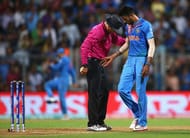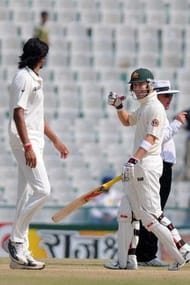When I was a young boy growing up in small-town North India, gully cricket was a common pastime. The kids in the colony would gather every weekend for a couple of hours and smash the ball around a local park.
The rules of the game would be modified according to our specific surroundings. If you whacked the ball into that strict uncle's garden, you were judged to have lost your wicket. LBWs weren't called and the worst batsmen were encouraged to hide the wickets with their bodies. There were no no-balls either, for the umpires were from the batting team and they couldn't be trusted to be impartial.
I suspect that most Indian cricketers start out similarly. Even in our group, there was a young boy who took his interest further. Every morning, he donned his whites and cycled to the stadium where he practised under a coach provided by the Sports Authority of India. After a period of tutelage, he was selected for a state tournament.
However, when I met him on the eve of the first match, he looked disheartened. Over sips of an aerated beverage, he told me that in the final practice, his coach had caught him bowling three no-balls in the nets. My friend had been pulled aside and informed that he wouldn’t be in the playing eleven for the next day.
“Swami Sir has a rule,” he ruefully said to me, “‘If you no-ball, then you will no-bowl.’”
Free-hits in Test matches
My friend’s coach had the right idea. Ever since free-hits have been introduced in the limited overs format, the number of no-balls has reduced considerably compared to Test cricket. It has been proven that as soon as the cost of bowling an illegal delivery increases, the bowlers become more careful.
The free-hit rule is one of the most popular additions to the rulebook recently. It enhances the level of excitement amongst the spectators and places appropriate punishment upon the fielding team. Given its success, it wouldn’t be surprising to see ICC introduce the rule in Test matches as well.
Imagine a batsman getting manhandled on a turning wicket, with four fielders around the bat. The ball hits the pad regularly and just misses the outside edge. A free-hit at this point would provide such welcome relief. All the pressure heaped upon the batsman would melt away and the bowler would again have to start from scratch.
If the ICC decides to impose any further penalties on no-balls in Test matches, it will affect the Indians more than other teams. They have, especially in the recent past, had a hard time with the rule. Perhaps it is a reflection of the fact that most players start playing the game as kids in colony parks where a slight overstep goes unnoticed.
Lessons not learnt
But under the constant gaze of watchful umpires and DRS cameras, any escape is impossible at the international level. Even with the penalty of a free-hit, Indian bowlers have bowled no-balls at crucial junctures in limited overs cricket.
During the World Twenty20 semi-finals last year, the Indian team paid dearly for overstepping the bowling crease. Twice they had taken the eventual match-winner Lendl Simmons’ wicket and twice did he escape because the deliveries were illegal. It is an asterisk the two bowlers - Ravichandran Ashwin and Hardik Pandya - will often find attached to their names, similar to how Chetan Sharma never escapes Javed Miandad’s last ball sixer against him at Sharjah in 1986.
In spite of the losses in the past, though, it seems the lessons aren’t being learnt. In the recent England tour of the subcontinent, the Indians bowled 13 no-balls as opposed to 5 by the English. During the New Zealand visit, the hosts’ no-ball count was again more than double that of their opponents.
Australia’s current tour is starting as another chapter in the same book. David Warner got a reprieve in the first innings of the first Test when he was bowled off a no-ball. Thankfully for the Indian fans, he got out a little later but the top batsmen have a habit of making the most of any breaks they are given.
A hard scrutiny required
There are multiple other instances one can recall, even if we only consider matches against Australian teams. When the Kangaroos visited India the last time, Michael Clarke was called back after Ishant Sharma’s delivery was declared invalid. In the Adelaide Test during India’s trip Down Under, Warner was bowled off a no-ball again.
This problem should no longer be treated matter-of-factly within the Indian bowling fraternity. If we look at other sports, the closest equivalent would probably be a foot fault in tennis. India has ambitions of being the top cricket team in the world and so the leading tennis players are good role models to follow.
The likes of Roger Federer and Rafael Nadal go through tournament after tournament without violating the court boundaries even once during their serves. Their feet just don’t move. Leander Paes takes a habitual step forward while serving and therefore has adjusted his stance. He starts his motion a couple of feet away from the baseline.
Such adjustments must easily be possible in cricket as well. If an Indian batsman doesn’t drag his bat across the crease while running, he is admonished and his technique corrected. Surely a bowler who carelessly oversteps deserves an equally hard scrutiny too?
I never met Swami Sir but I imagine him to be a tall, wiry man. In my mind’s eye, I see him sitting alone in front of his television set with a cricket ball in his hand and a floppy hat on his head. When Jayant Yadav bowled that no-ball in the Pune Test to let off Warner, he must have leapt up and screamed. No one would have heard him.
Perhaps someone should.
Follow IPL Auction 2025 Live Updates, News & Biddings at Sportskeeda. Get the fastest updates on Mega-Auction and cricket news


